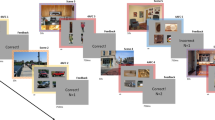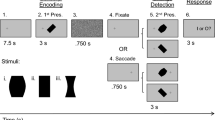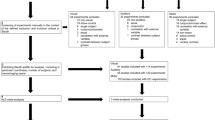Abstract
The cerebellum is thought to help coordinate movement. We tested this using functional magnetic resonance imaging (fMRI) of the human brain during visually guided tracking tasks requiring varying degrees of eye–hand coordination. The cerebellum was more active during independent rather than coordinated eye and hand tracking. However, in three further tasks, we also found parametric increases in cerebellar blood oxygenation signal (BOLD) as eye–hand coordination increased. Thus, the cerebellar BOLD signal has a non-monotonic relationship to tracking performance, with high activity during both coordinated and independent conditions. These data provide the most direct evidence from functional imaging that the cerebellum supports motor coordination. Its activity is consistent with roles in coordinating and learning to coordinate eye and hand movement.
This is a preview of subscription content, access via your institution
Access options
Subscribe to this journal
Receive 12 print issues and online access
$209.00 per year
only $17.42 per issue
Buy this article
- Purchase on Springer Link
- Instant access to full article PDF
Prices may be subject to local taxes which are calculated during checkout





Similar content being viewed by others
References
Flourens, P. The Human Brain and Spinal Cord (eds. Clarke, E. & O'Malley, C. D.) 657–661 (Univ. California Press, Berkeley, 1968).
Bastian, A. J., Martin, T. A., Keating, J. G. & Thach, W. T. Cerebellar ataxia: abnormal control of interaction torques across multiple joints. J. Neurophysiol. 76, 492–509 (1996).
Muller, F. & Dichgans, J. Dyscoordination of pinch and lift forces during grasp in patients with cerebellar lesions. Exp. Brain Res. 101, 485–492 (1994).
Serrien, D. J. & Wiesendanger, M. Temporal control of a bimanual task in patients with cerebellar dysfunction. Neuropsychologia 38, 558–565 (2000).
Van Donkelaar, P. & Lee, R. G. Interactions between the eye and hand motor systems: disruptions due to cerebellar dysfunction. J. Neurophysiol. 72, 1674–1685 (1994).
Vercher, J. L. & Gauthier, G. M. Cerebellar involvement in the coordination control of the oculo-manual tracking system: effects of cerebellar dentate nucleus lesion. Exp. Brain Res. 73, 155–166 (1988).
Miall, R. C. The cerebellum, predictive control and motor coordination. Novartis Found. Symp. 218, 272–290 (1998).
Miall, R. C., Imamizu, H. & Miyauchi, S. Activation of the cerebellum in coordinated eye and hand tracking movements: an fMRI study. Exp. Brain Res. 135, 22–33 (2000).
Marple-Horvat, D. E., Criado, J. M. & Armstrong, D. M. Neuronal activity in the lateral cerebellum of the cat related to visual stimuli at rest, visually guided step modification, and saccadic eye movements. J. Physiol. (Lond.) 506, 489–514 (1998).
Abrams, R. A., Meyer, D. E. & Kornblum, S. Eye-hand coordination: oculomotor control in rapid aimed limb movements. J. Exp. Psychol. 16, 248–267 (1990).
Koken, P. W. & Erkelens, C. J. Influences of hand movements on eye movements in tracking tasks in man. Exp. Brain Res. 88, 657–664 (1992).
Vercher, J. L., Magenes, G., Prablanc, C. & Gauthier, G. M. Eye–head–hand coordination in pointing at visual targets: spatial and temporal analysis. Exp. Brain Res. 99, 507–523 (1994).
Biguer, B., Prablanc, C. & Jeannerod, M. The contribution of coordinated eye and head movements in hand pointing accuracy. Exp. Brain Res. 55, 462–469 (1984).
Petit, L. & Haxby, J. V. Functional anatomy of pursuit eye movements in humans as revealed by fMRI. J. Neurophysiol. 82, 463–471 (1999).
Berman, R. A. et al. Cortical networks subserving pursuit and saccadic eye movements in humans: an FMRI study. Hum. Brain Mapp. 8, 209–225 (1999).
Nishitani, N. Cortical visuomotor integration during eye pursuit and eye-finger pursuit. J. Neurosci. 19, 2647–2657 (1999).
Grafton, S. T., Mazziotta, J. C., Woods, R. P. & Phelps, M. E. Human functional anatomy of visually guided finger movements. Brain 115, 565–587 (1992).
Jueptner, M., Jenkins, I. H., Brooks, D. J., Frackowiak, R. S. J. & Passingham, R. E. The sensory guidance of movement: a comparison of the cerebellum and basal ganglia. Exp. Brain Res. 112, 462–474 (1996).
Turner, R. S., Grafton, S. T., Votaw, J. R., DeLong, M. R. & Hoffman, J. M. Motor subcircuits mediating the control of movement velocity: a PET study. J. Neurophysiol. 80, 2162–2176 (1998).
Jenkins, I. H., Brooks, D. J., Nixon, P. D., Frackowiak, R. S. J. & Passingham, R. E. Motor sequence learning: a study with positron emission tomography. J. Neurosci. 14, 3775–3790 (1994).
Clower, D. M. et al. Role of posterior parietal cortex in the recalibration of visually guided reaching. Nature 383, 618–621 (1996).
Imamizu, H. et al. Human cerebellar activity reflecting an acquired internal model of a new tool. Nature 403, 192–195 (2000).
Flament, D., Ellermann, J. M., Kim, S. G., Ugurbil, K. & Ebner, T. J. Functional magnetic resonance imaging of cerebellar activation during the learning of a visuomotor dissociation task. Hum. Brain Mapp. 4, 210–226 (1996).
Allen, G., Buxton, R. B., Wong, E. C., Courchesne, E. Attentional activation of the cerebellum independent of motor involvement. Science 275, 1940–1943 (1997).
Ivry, R. Cerebellar timing systems. Int. Rev. Neurobiol. 41, 555–573 (1997).
Shadmehr, R. & Holcomb, H. H. Neural correlates of motor memory consolidation. Science 277, 821–825 (1997).
Roland, P. E. & Gulyas, B. Visual memory, visual imagery, and visual recognition of large field patterns by the human brain: functional anatomy by positron emission tomography. Cereb. Cortex 5, 79–93 (1995).
Fletcher, P. C., Shallice, T., Frith, C. D., Frackowiak, R. S. & Dolan, R. J. Brain activity during memory retrieval. The influence of imagery and semantic cueing. Brain 119, 1587–1596 (1996).
Ghaem, O. et al. Mental navigation along memorized routes activates the hippocampus, precuneus, and insula. Neuroreport 8, 739–744 (1997).
Tamada, T., Miyauchi, S., Imamizu, H., Yoshioka, T. & Kawato, M. Cerebro-cerebellar functional connectivity revealed by the laterality index in tool-use learning. Neuroreport 10, 325–331 (1999).
Van Donkelaar, P., Lee, R. G. & Gellman, R. S. The contribution of retinal and extraretinal signals to manual tracking movements. Exp. Brain Res. 99, 155–163 (1994).
Ferraina, S. et al. Visual control of hand-reaching movement: activity in parietal area 7m. Eur. J. Neurosci. 9, 1090–1095 (1997).
Vercher, J. L. et al. Self-moved target eye tracking in control and deafferented subjects: roles of arm motor command and proprioception in arm–eye coordination. J. Neurophysiol. 76,1133–1144 (1996).
Witney, A. G., Goodbody, S. J. & Wolpert, D. M. Predictive motor learning of temporal delays. J. Neurophysiol. 82, 2039–2048 (1999).
Miall, R. C. & Wolpert, D. M. Forward models for physiological motor control. Neural Net. 9, 1265–1279 (1996).
Pelisson, D., Prablanc, C., Goodale, M. A. & Jeannerod, M. Visual control of reaching movements without vision of the limb. II. Evidence of fast unconscious processes correcting the trajectory of the hand to the final position of a double-step stimulus. Exp. Brain Res. 62, 303–311 (1986).
Lewis, R. F., Gaymard, B. M. & Tamargo, R. J. Efference copy provides the eye position information required for visually guided reaching. J. Neurophysiol. 80, 1605–1608 (1998).
Miall, R. C., Weir, D. J. & Stein, J. F. Visuomotor tracking with delayed visual feedback. Neuroscience 16, 511–520 (1985).
Vercher, J. L. & Gauthier, G. M. Oculo-manual coordination control: ocular and manual tracking of visual targets with delayed visual feedback of the hand motion. Exp. Brain Res. 90, 599–609 (1992).
Wolpert, D. M. Multiple paired forward and inverse models for motor control. Neural Net. 11, 1317–1329 (1998).
Waldvogel, D., van Gelderen, P., Ishii, K. & Hallett, M. The effect of movement amplitude on activation in functional magnetic resonance imaging studies. J. Cereb. Blood Flow Metab. 19, 1209–1212 (1999).
Vanmeter, J. W. et al. Parametric analysis of functional neuroimages– application to a variable-rate motor task. Neuroimage 2, 273–283 (1995).
Jenkins, I. H., Passingham, R. E. & Brooks, D. J. The effect of movement frequency on cerebral activation: a positron emission tomography study. J. Neurol. Sci. 151, 195–205 (1997).
Winstein, C. J., Grafton, S. T. & Pohl, P. S. Motor task difficulty and brain activity: Investigation of goal-directed reciprocal aiming using positron emission tomography. J. Neurophysiol. 77, 1581–1594 (1997).
Poulton, E. C. Tracking Skill and Manual Control (Academic, New York, 1974).
Woods, R. P., Grafton, S. T., Holmes, C. J., Cherry, S. R. & Mazziota, J. C. Automated image registration: I. General methods and intrasubject, intramodality validation. J. Comput. Assist. Tomogr. 22, 141–154 (1998).
Friston, K. J., Worsley, K. J., Frackowiak, R. S. J., Mazziota, J. C. & Evans, A. C. Assessing the significance of focal activations using their spatial extent. Hum. Brain Mapp. 1, 214–220 (1994).
Talairach, J. & Tournoux, P. Co-Planar Stereotaxic Atlas of the Human Brain (Thieme, Stuttgart, 1988).
Schmahmann, J. D. et al. Three-dimensional MRI atlas of the human cerebellum in proportional stereotaxic space. Neuroimage 10, 233–260 (1999).
Acknowledgements
We thank the Wellcome Trust, JST ERATO, the Oxford FMRIB and MRC Cognitive Neuroscience Centers for help and facilities, and G. Swait and N. Jenkinson for supplementary data collection.
Author information
Authors and Affiliations
Corresponding author
Rights and permissions
About this article
Cite this article
Miall, R., Reckess, G. & Imamizu, H. The cerebellum coordinates eye and hand tracking movements. Nat Neurosci 4, 638–644 (2001). https://doi.org/10.1038/88465
Received:
Accepted:
Issue Date:
DOI: https://doi.org/10.1038/88465
This article is cited by
-
Course induced dexterity development and cerebellar grey matter growth of dentistry students: a randomised trial
Scientific Reports (2021)
-
Awareness of voluntary action, rather than body ownership, improves motor control
Scientific Reports (2021)
-
The complexity of eye-hand coordination: a perspective on cortico-cerebellar cooperation
Cerebellum & Ataxias (2020)
-
Sex differences in visuomotor tracking
Scientific Reports (2020)
-
Activation of cerebellum and basal ganglia during the observation and execution of manipulative actions
Scientific Reports (2020)



